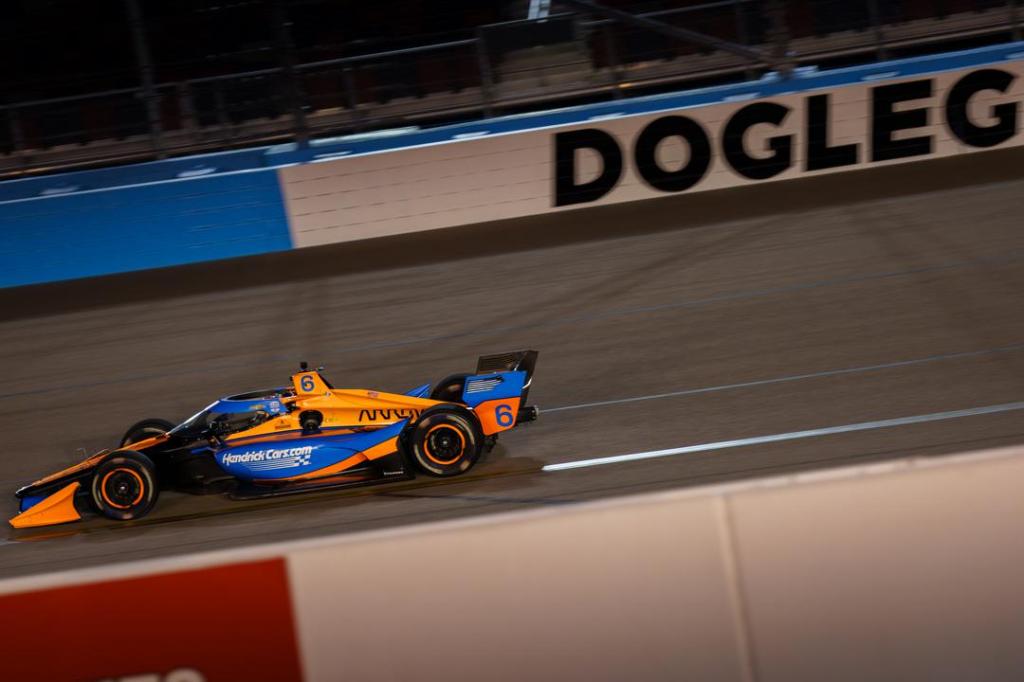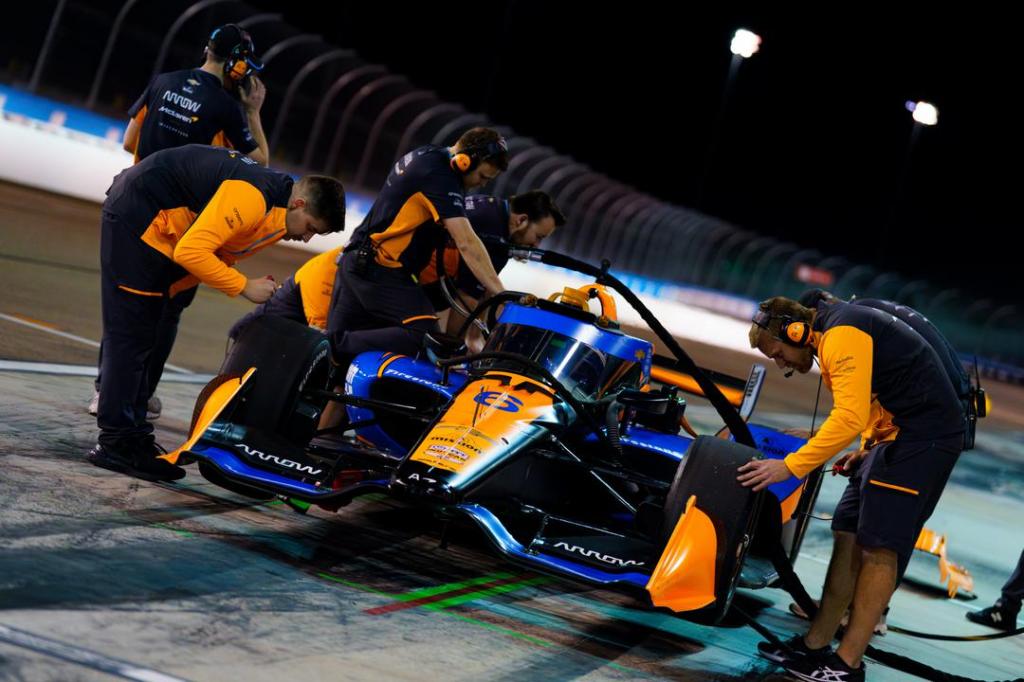
At first blush, Kyle Larson testing at Phoenix Raceway in advance of the Indianapolis 500 doesn’t seem to offer a ton of synergy but it did make him uncomfortable at times and that was the point.
Even if not a ton translates from the one miler in the desert to the 2.5-mile Racing Capital of the World, Larson wanted to learn as much about driving this car as possible and that is to say nothing of building chemistry with his engineering team.
“It’s a totally different racetrack and all that,” Larson said during an IndyCar conference call on Wednesday, a day after his test. “The banking through (Turns) 3 and 4 is not too different than Indy.
“I had a few moments where I was uncomfortable. I thought that was good to feel at 190 or whatever we’re going, 180 maybe in the corner, compared to going 220 at Indy, having the moment, being surprised by something. I think that was a benefit.”

For him, everything comes down to seat time and doing everything he can to bridge the experience gap leading up to the month of May. This was only his second time in the car after completing his rookie orientation in October at the Indianapolis Motor Speedway.
“I think, just getting more reps of pulling in and out of the (pit) box, messing with the weight jacker and bar and all that,” Larson said. “I didn’t really mess with any of that during my rookie orientation just because the balance was so good. I didn’t really feel like I needed to do anything.
“Yesterday my balance was kind of transitioning quickly. Kind of had to try to keep up with that a little bit. I’m not used to having cockpit adjustors. That’s what you have to do a lot of in an Indy car.
“It was just good to kind of do all that stuff, log some notes in my brain. Hopefully make the transition, when I get to Indy, smoother and quicker, and we can really just get to working on the important stuff with the car and things like that once we get to the month of May.”
Larson wasn’t even supposed to test until Wednesday but the same storm that resulted in an impromptu Busch Clash on Saturday, one day earlier than scheduled, forced the McLaren Indy team to do the same thing with this test session.
They ran through five sets of tires at about 40 laps per set so around 200 overall laps.
The most uncomfortable moment for Larson came in the final run of the day and the car was getting progressively tighter … or as he is learning to call it in IndyCar vernacular, understeer.
“We went to do a long run, had different air pressures and stuff to start,” Larson said. “The car felt a lot different early in the run. I kind of had my mind made up that it was going to build tighter. It was like starting to get loose pretty quickly. I was a bit confused (and) wasn’t quite expecting that. I was trying to make adjustments on the weight jacker and things like that.
“Just got caught off guard a little bit. I had some warnings a few laps before. I went into IndyCar turmoil. Got a little bit loose into the corner, got to the apex. As I was leaving the bottom, it just started to get sideways (but) was able to catch it.”

With that said, Larson said he was surprised about how much his NASCAR race craft actually translated to the Indy car in its short oval trim.
“Honestly, though, nothing about yesterday felt way different than what a Cup car, NextGen car, feels like. That was good for me. I think the characteristics of the Indy car versus the Cup car, at least at Phoenix, felt very similar. You’re just going a lot faster in an Indy car.
“The moments happen a lot quicker. The edge of good versus not good feels a lot sharper (but) it didn’t feel way, way different than what I was, I guess, used to. Even with those moments of getting sideways, it didn’t feel way different.”
Larson also practiced pit stops, which was something that will translate to The Greatest Spectcle in Racing come May.
“That was good because pit stops are a lot quicker than what I’m used to,” he said. “In a stockcar, all you’re really worried about is popping it into neutral, coasting in, holding the brake pedal, they drop the car, put it in first gear and you take off. It’s similar to that.
Now I’m listening to tones in my headphones when they unplug. I can’t go into first gear until it’s unplugged. The timing and the window for that are much smaller. Yesterday, doing it, it feels like it’s all happening so fast.
“With the more reps I think I get, that will slow down for me. I’ll get to where I can nail things a little bit better more consistently. So, yeah, just getting more reps is going to be important.”
And then there is the lingo, which is a legitimate challenge to overcome, because IndyCar drivers and NASCAR drivers have such different ways of articulating the same handling concepts. Larson said he isn’t sure how much he needs to adapt to their terminologies or how much they need to adapt to his.
It’s all part of the process and the reality will probably be closer to the two sides bridging and meeting in the middle.
“It’s difficult for me, like I really have to think about what is oversteer and what is understeer just because my whole life I’ve been loose or tight,” Larson said. “I think that’s more of something like they maybe, the engineers, need to get comfortable with my terminology more than me getting in touch with their terminology. But I’m not really sure.
“I’m getting better at speaking their language, but it’s just weird. I don’t know why I can’t just say loose or tight.”
He said that list bit with a laugh.
“There’s time,” he said. “It’s simpler than I make it sound I think to figure out weight jacker stuff, cockpit adjustment stuff.”
It also helps that Larson has engineer Brian Campe on his team. Campe won an IndyCar championship in 2017 with Team Penske and is also an Indianapolis 500 winning engineer. He is now at Hendrick Motorsports in NASCAR serving as technical director.
Larson didn’t realize Campe had that sort of notoriety in IndyCar until they spent 500 race day together last year.
“When we walked in there, all these race fans and mechanics were coming up to him,” Larson said. “I was like, ‘Man, this guy is like a celebrity around here.’ That was really eye-opening to me.
“From there, I kind of asked him some questions on the flight home of, like, I didn’t know this about you. He went through his career path. I thought it was very unique.
“Coming from Penske on the NASCAR side to IndyCar and having so much success really quickly, then end up in the role that he’s at now at Hendrick… before I knew all this, I was like, ‘Man, this Brian Campe guy, he’s super smart. Just throughout our competition meetings, stuff like that. Once we got to Indy, it all made sense why he is who he is.
“I hope we can utilize him a lot. He’s obviously well respected, got a great résumé, a really smart mechanic/engineer person. You want all the best people in your corner, and he’s definitely a really, really smart guy.”

Ultimately, it was a positive test and one that Larson came away with surprised at how similar the IndyCar is to the current Cup car. Maybe that doesn’t mean much at wide-open, full-throttle Indianapolis but that is where his Sprint Car experience will translate.
Or at least, he hopes.
“The IndyCar and Sprint Car stuff, runs happen so fast,” Larson said. “You pass somebody, you put 10 car lengths by the time you get to the next corner. Where stock cars, you have to inch toward that, slowly, slowly.
“You spend two laps inside of them, then you finally get clear. It’s harder to get to somebody, pass them, and get away. IndyCar and Sprint Cars, those runs happen quicker, checkups happen quicker, stuff like that.
“I think, or I hope, being used to the Sprint Car and how quickly moves happen, I hope that allows me to be more confident when we get into kind of racing situations in the IndyCar. I’ve yet to be on track with anybody else, so I don’t know. That’s all me just assuming from watching videos and stuff. Yeah, just the quickness, the weight, all that I think will be similar. The balance stuff I think IndyCar and stock cars are more similar.”
Matt Weaver is a Motorsports Insider for Sportsnaut. Follow him on Twitter.

